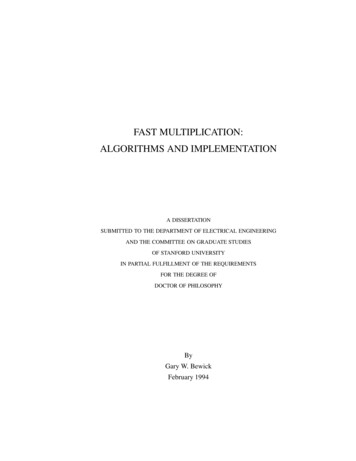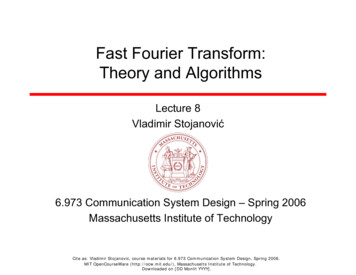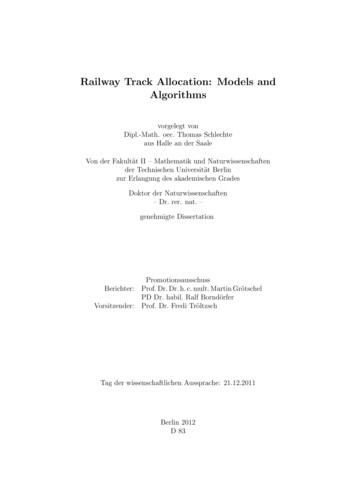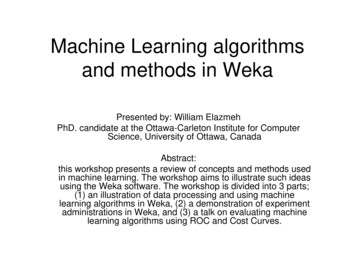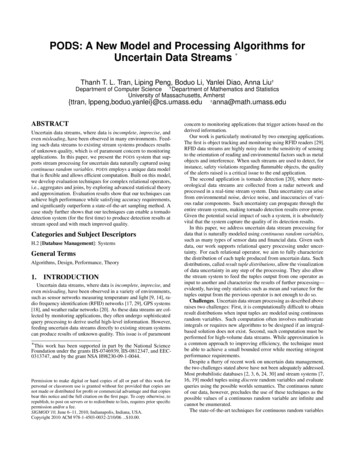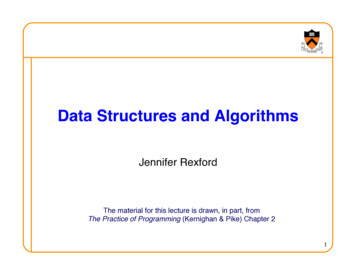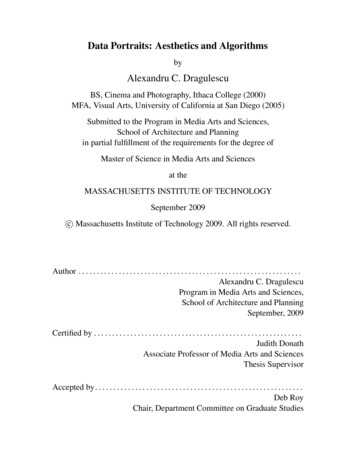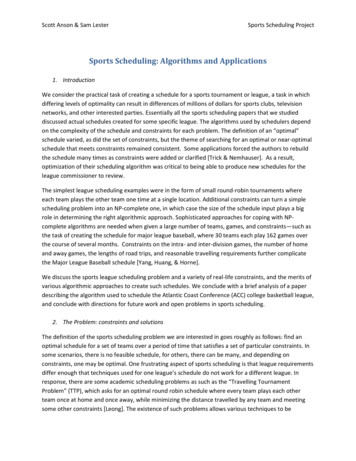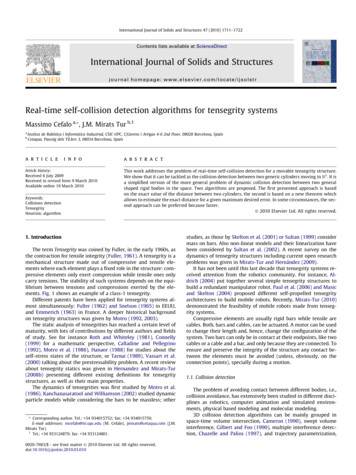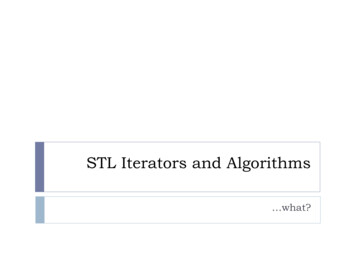
Transcription
STL Iterators and Algorithms what?
IteratorsSet int mySet;// initialize mySet.foreach (int value in mySet)cout value endl;This code creates and initializes a set of integers, and then printsout everything in the set. However, it uses Stanford-specificlibraries that aren’t readily available outside of CS106B.Iterators and Algorithms
IteratorsTo implement the same thing using standard C , we’ll use an objectcalled an “iterator.” An iterator is intimately tied to a particular datastructure; it provides a “view” into that data structure, giving you themeans to access and modify different elements.You can think of an iterator as a remarkably intelligent elf that lives insidethe data structure. His job is to report all the different elements that residein the set. At any point in time, he is standing on top of and looking at oneelement. In order to do his job, he responds to two commands: You can ask the elf what element he’s currently looking at. He will lookdown and report what he sees. You can ask the elf to move to the next element. He will hop fromwhere he is to the next spot, where he will now be standing on top of anew element.Iterators and Algorithms
Iterator Syntaxset int mySet;// initialize mySet.set int ::iterator itr mySet.begin();while (itr ! mySet.end()) {cout *itr endl;itr ;}This is equivalent to the code with the foreach, except it uses standardC . Note that Set int has become set int (lower case ‘s’). Also, we#include set rather than #include “set.h”. The printing loop uses aniterator, just as described before.Iterators and Algorithms
Iterator Syntaxset int mySet;// initialize mySet.set int ::iterator itr mySet.begin();while (itr ! mySet.end()) {cout *itr endl;itr ;}The iterator object is a C object, so it has a type, highlighted above:set int ::iterator. We specify that it belongs in the scope of set int because the iterator which understands how to traverse a set iscompletely from the iterator which understands how to traverse a vector,or a linked list. Each iterator type is specialized to understand oneparticular data structure.Iterators and Algorithms
Iterator Syntaxset int mySet;// initialize mySet.set int ::iterator itr mySet.begin();while (itr ! mySet.end()) {cout *itr endl;itr ;}The set (as well as the other container classes in C ) exports the.begin() and .end() methods, both of which return special set iterators.end() will be explained shortly; .begin() simply returns an iteratorlooking at the very first element in the set.Iterators and Algorithms
Iterator Syntaxset int mySet;// initialize mySet.set int ::iterator itr mySet.begin();while (itr ! mySet.end()) {cout *itr endl;itr ;}Finally, to use the two “commands” we can give our iterator, we use thedereference operator (*) and the increment operator ( ). Dereferencingthe iterator returns a reference to whatever element the iterator iscurrently looking at, while incrementing it moves it to the next element.The syntax is intentionally similar to pointer syntax; you can almost thinkof the iterator as a special sort of pointer that describes where things livein a data structure, rather than in memory.Iterators and Algorithms
Iterator Syntaxset int mySet;// initialize mySet.set int ::iterator itr mySet.begin();while (itr ! mySet.end()) {cout *itr endl;itr ;}The condition of the while loop describes how long we keep looping,alternately reading data and moving to the next element. While it wouldintuitively seem as though .end() returns an iterator looking at the lastelement in the data structure, this is NOT the case. To see why, considerwhat happens if we replace the condition of the while loop with true.Iterators and Algorithms
Ending Iterator Loopswhile (true) {cout *itr endl;itr ;}Above is the modified loop code. Suppose we are iterating over somecontainer with the five elements listed below. We will animate what exactlyhappens with the help of our furry friend, Wile E. Coyote.0123Iterators and Algorithms4
Ending Iterator Loopscondition checkdata accessincrementtrue*itritr The loop has three main components: a condition check, the data access,and the increment. The corresponding bits of code are shown above. WileE. Coyote starts off at the beginning of the container.0123Iterators and Algorithms4
Ending Iterator Loopscondition checkdata accessincrementtrue*itritr 0123Iterators and Algorithms4
Ending Iterator Loopscondition checkdata accessincrementtrue*itritr 00123Iterators and Algorithms4
Ending Iterator Loopscondition checkdata accessincrementtrue*itritr 0123Iterators and Algorithms4
Ending Iterator Loopscondition checkdata accessincrementtrue*itritr 0123Iterators and Algorithms4
Ending Iterator Loopscondition checkdata accessincrementtrue*itritr 10123Iterators and Algorithms4
Ending Iterator Loopscondition checkdata accessincrementtrue*itritr 0123Iterators and Algorithms4
Ending Iterator Loopscondition checkdata accessincrementtrue*itritr 0123Iterators and Algorithms4
Ending Iterator Loopscondition checkdata accessincrementtrue*itritr 20123Iterators and Algorithms4
Ending Iterator Loopscondition checkdata accessincrementtrue*itritr 0123Iterators and Algorithms4
Ending Iterator Loopscondition checkdata accessincrementtrue*itritr 0123Iterators and Algorithms4
Ending Iterator Loopscondition checkdata accessincrementtrue*itritr 30123Iterators and Algorithms4
Ending Iterator Loopscondition checkdata accessincrementtrue*itritr 0123Iterators and Algorithms4
Ending Iterator Loopscondition checkdata accessincrementtrue*itritr 0123Iterators and Algorithms4
Ending Iterator Loopscondition checkdata accessincrementtrue*itritr Wile E. Coyote has just read the last element in the container. Dangerabounds! He is about to increment and step off the end of the container 40123Iterators and Algorithms4
Ending Iterator Loopscondition checkdata accessincrementtrue*itritr but that’s okay! It turns out, Wile E. Coyote never falls immediately whenhe runs off the edge of a cliff. In fact, he will keep running 0123Iterators and Algorithms4
Ending Iterator Loopscondition checkdata accessincrementtrue*itritr and stay perfectly safe, as long as he keeps running 0123Iterators and Algorithms4
Ending Iterator Loopscondition checkdata accessincrementtrue*itritr until he looks down. The equivalent action by the iterator is the dataaccess by the dereference operator.uh oh 0123Iterators and Algorithms4
Ending Iterator Loopscondition checkdata accessincrementtrue*itritr Once he looks down, Wile E. Coyote falls and is mildly injured. When we call*itr where itr points somewhere bad, the program might crash, or it mightreturn garbage data.0123Iterators and Algorithms4
Ending Iterator Loopswhile (itr ! mySet.end()) {cout *itr endl;itr ;}end()To fix this loop, we’ll replace true with a check that tells us whenWile E. Coyote has run off the end of the container. We use aspecial iterator that points to the location one spot past the lastelement. When Wile E. Coyote reaches this point, he’ll know not tolook down.0123Iterators and Algorithms4STOP
Ending Iterator Loopscondition checkdata accessincrementitr ! mySet.end()*itritr Suppose Wile E. Coyote is looking at thelast element in the container. At this point, hehasn’t reached the same location where.end() points, so he continues iterating.0123Iterators and Algorithmsend()4STOP
Ending Iterator Loopscondition checkdata accessincrementitr ! mySet.end()*itritr The data access works fine here. It’s the lasttime that it will in this loop.0123Iterators and Algorithms44end()STOP
Ending Iterator Loopscondition checkdata accessincrementitr ! mySet.end()*itritr The increment takes him past the end of thecontainer, but that’s okay since he hasn’t yetlooked down.012end()3Iterators and Algorithms4STOP
Ending Iterator Loopscondition checkdata accessincrementitr ! mySet.end()*itritr At this point, the condition check evaluatesto false, because he is at the same locationthat .end() marks. The loop ends, and henever makes the mistake of looking down,so he’s completely safe.012end()3Iterators and Algorithms4STOP
Universal Iterator SyntaxIterators for any STL-compliant container all share the same syntax forreading/writing and increment. For example, the three loops below print thecontents of a set, a vector, and a linked list, respectively.set int ::iterator itr mySet.begin();while (itr ! mySet.end()) {cout *itr endl;itr ;}vector int ::iterator itr myVector.begin();while (itr ! myVector.end()) {cout *itr endl;itr ;}list int ::iterator itr myList.begin();while (itr ! myList.end()) {cout *itr endl;itr ;}In all three cases, only the iterator type and the name of the container change.Iterators and Algorithms
Why iterators?The reason universal iterator syntax is important because of the role theyplay in the use of STL algorithms. “Algorithm” is a general math andprogramming term; in the context of C , we’re talking about a part of thestandard libraries that provides a large variety of useful functionality we canleverage against the data stored in containers.-ithms!Iterators and Algorithms
STL AlgorithmsThe STL algorithms are a group of functions that perform interesting operationson data that you supply. For example, there are algorithms to: sort dataperform linear or binary searchesmerge two sorted listscount the number of appearances of some particular element and the list goes on. The algorithms were designed not to need to know howyour data is stored, so they operate by accepting iterator ranges rather thancontainers. An iterator range consists of a pair of iterators designating the startand end of the data being supplied as input.For example, if you wanted to sort everything in myVector, you would passmyVector.begin() and myVector.end() into the sort algorithm.Iterators and Algorithms
STL AlgorithmsHere is some sample code which copies all elements from a set over to avector, and then randomly shuffles the vector elements.set int mySet;// initialize mySet vector int myVector(mySet.size()); // myVector has the same size// as mySet// The first two arguments to copy are iterators describing the input// range. The third argument is where to write the results. myVector// must have enough space!copy(mySet.begin(), mySet.end(), myVector.begin());random shuffle(myVector.begin(), myVector.end());Iterators and Algorithms
Magic SquaresThe following programming example, solvingmagic squares, illustrates the power ofhaving the STL algorithms at your disposal.A magic square is a three-by-three grid ofnumbers in which each of the numbers 1through 9 appears exactly once, as shown onthe right. A key property of valid magicsquares is that every row, every column, andeach of the two diagonals must sum up to thesame value.In the case of the magic square on the right(and in fact, all three-by-three magicsquares), that common sum is 15.276951438Iterators and Algorithms
Magic SquaresWe are going to find all magic squares by brute-force checking every possiblearrangement of the numbers 1 through 9 in the grid. To make this easierprogrammatically, we’ll express the grid as an array in “row-major” form,meaning that the first row comprises the first three indices, the second rowcomprises the next three, and so on. Then, we’ll just generate all possiblepermutations of that array.27695143Iterators and Algorithms2769514388
Permutations123132213231312321As it turns out, there is an STL algorithm callednext permutation that generates permutations sequentially.It accepts an iterator range consisting of numbers withsome ordering, and rearranges them to form the “next”permutation in the list of all possible permutations, wherethose permutations are sorted in increasing order from leftto-right.For example, for the list (1, 2, 3), all six permutations areordered on the left, sorted by the first element first, secondelement next, and so on. If we were to pass (1, 2, 3) intonext permutation, it would produce (1, 3, 2). Passing thatinto the algorithm would in turn produce (2, 1, 3).Eventually, when (3, 2, 1) is the input, (1, 2, 3) is produced,but the function returns false to indicate that it’s finishedprocessing all permutations.Iterators and Algorithms
Magic Squaresnext permutation can be used in a loop to process all possible permutations ofa list of numbers. We’ll use this to solve magic squares by representingpossible squares as vectors in row-major form.Assume that IsMagicSquare and PrintSquare are already implemented(prototypes shown below). The former returns true if the vector passed inrepresents a grid with the magic square properties, and the latter simply printsthe contents of the vector in a nice grid format.bool IsMagicSquare(const vector int & candidate);void PrintSquare(const vector int & square);Iterators and Algorithms
Magic Squaresint main() {vector int candidate;for (int i 1; i 9; i )candidate.push back(i);// sort isn’t necessary in this case, but it’s important when// iterating through permutations to make sure to start at// the beginning.sort(candidate.begin(), candidate.end());do {if (IsMagicSquare(candidate)) {cout “Solution:” endl;PrintSquare(candidate);}} while (next permutation(candidate.begin(), candidate.end());return 0;}Iterators and Algorithms
Iterators and Algorithms 2 7 6 9 5 1 4 3 8 The following programming example, solving magic squares, illustrates the power of having the STL algorithms at your disposal. A magic square is a three-by-three grid of numbers in which each of the numbers 1 through 9 appears exactly o

